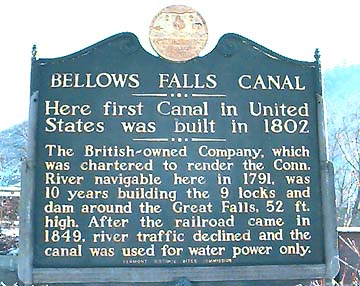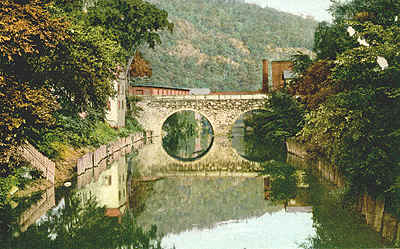

In the background is Fall Mountain in winter.
Note: This title of "first canal in United States" is claimed by many canals. The Bellows Falls Canal may be "the first canal in the United States that is still used industrially". (It's used as a sluiceway for a electric power plant.)
Other first canals in the United States:
If canals are defined as any artificial waterway, then prehistoric irrigation canals may have been first.
The Cut River or Break Through in Plymouth Colony connected Plymouth Harbor with Marshfield on Green Harbor, documented in 1636. A March 1966 Yankee Magazine article by Edward Rowe Snow titled "America's FIRST Canal" claims this to be just that. The cut created an inland waterway connecting the coastal towns and avoided Gurnet Point, which was long and perilous for the colony's small craft. The Green Harbor River provided passage to South River and Scituate (SITCH-you-it) further north, all without ocean perils. Marshfield deserves its marshy name and the author notes that the route was always passable during the highest tides at full moon and new moon. The dredging slowly increased the time it was navigable. The Plymouth Colony Laws of 1623-1682, page 25 (1636), reads, "It is also ordered by the Court that the Cut at Green Harbor for a boat passage shalbe made eighteene foote wide and sixe foote deepe." Eventually it was passable "20 hours out of the 24." By 1850, Gurnet Light was erected and the large, ocean-worthy craft had no need of the circuitous, tide-dependent Cut River route, which slowly silted in.
Mother Brook in Dedham, Massachusetts Bay Colony, a "diversion" canal, connected the Charles and Neponset Rivers in 1639 and is claimed as the "first major canal" and the "oldest industrial canal" in the United States. Apparently, the slow Charles River couldn't support a mill for the early settlers of Dedham, southwest of Boston. The diversion to the Neponset River made for a good head of water (and also lawsuits from mills downstream on the Charles). Today, a quarter of the water in the Charles is still diverted to the Neponset River and the Hyde Park section of Boston still has Mill Pond on Mother Brook. See Ron McAdow's webpage.
"The Neck Diged through in 1730" on the Mohawk River near Rome, New York (then Fort Stanwick) could well be the first navigation canal in the US. It bypassed a long oxbow and had no locks and no tolls. Travelers from the Hudson River could continue from Rome over a one-mile portage that led to Wood Creek, Lake Oneida, and finally Lake Ontario and the western frontier. See the NY State Museum website.
The Schuylkill and Susquehanna Canal Company has a claim as the first canal to be surveyed in the United States, in 1762 and again in 1770. It's also claimed as the first "public canal" company in the country. "Some random blasting" in 1763 could support a claim as the first construction on a canal with locks. Work started finally in 1792. The money ran out after 5 locks were completed and the company went bankrupt. The Union Canal Company began work again in 1821, finishing it in 1828. See the Manayunk section of the Schuylkill Canal website (near Philadelphia)
The James River Canal is claimed as the "first canal system in the nation" on the City of Richmond, Virginia website and the "first operating canal system with locks in the U.S." by the James River Batteau Festival (in 2002). It was also known as the James River and Kanawha Canal, with the hope of connecting to the Kanawha River on the west side of the Alleghenies and then to the Ohio River. It "dates back to 1785". Some websites say it was completed in 1789, but it's not clear just what was completed. The "falls" near Richmond were rapids with no vertical waterfalls. The English word "falls" can be ambiguous that way. (see Whitewater Rafting on the James). Some websites refer to "sluice navigation", where wing dams were used to deepen the channels. That way, very strong men with very flat (one-foot draft) "bateaux" could pole up the rapids--more of an Olympic sport than a canal. George Washington was an officer in this company, as well as the Potomac Company. In 1841, money was raised to extend the canal to Lynchburg. That project was finished in 1851. In 2000, Cabell's Canal: the Story of the James River and Kanawha Canal by Langhorne Gibson was published. Maybe that book has more information about the original 1785-1789 project.
A group of Baltimore merchants in 1783 petitioned the State of Maryland for permission to build the "Susquehanna Canal" to the Pennsylvania line on the east bank of the Susquehanna. This canal, variously referred to as the "Susquehanna Canal", "Port Deposit Canal", or "Conowingo Canal" (as in the Maryland town, not to be confused with the Conewago Canal below, also on the Susquehanna), ran from a tidewater connection near Rock Run to Love Island, just below the Mason-Dixon line. It was officially opened in 1801, but was never financially successful. In 1817, the sheriff of Cecil County sold the canal at public auction. The canal was finally abandoned when the Susquehanna and Tidewater Canal began operations.
Virginia's Patowmack Company was incorporated in 1785 to build canals with locks around five impassable sections of the Potomac River. General George Washington was president. Construction was completed in 1802 (I don't know if it was after the Bellows Falls Canal). These canals may be the first canals with locks chartered in the US. It was not a success and little remains today. The better Chesapeake and Ohio Canal was first opened in 1831, paralleling the Potomac River and completely avoiding the river (and the old canals) and thus avoiding problems of low water from drought and high water from flood. See the Great Falls Park webpage. (Note that several canals in the U.S. bypass something locally known as Great Falls, including Bellows Falls and Conewago.)
The South Hadley Canal in Massachusetts seems to be the first canal completed to bypass rapid water in the nation, in 1794. It was the first navigation canal perhaps in the sense that it created a new navigation route (as opposed to the Mohawk's "neck diged through", which was a shortcut on an already-navigable route). It did not use locks, but carts on an inclined plane dragged by water power, a technique already used in England. See the South Hadley Canal Committee page.
The Little Falls Canal on the Mohawk River in Little Falls, NY may be the first canal with locks in the nation, begun in 1793 and finished in 1795. There are some ruins visible. See the NY State Historical Survey website.
The Conewago Canal avoided the treacherous Conewago Falls below Middletown, Pennsylvania, near Harrisburg, was certainly that state's first artificial waterway. It was built on the west bank of the Susquehanna. Its purpose was to link river traffic safely with Columbia and with the turnpike which ran from that town to Philadelphia. There are no claims that this is first, but it is older than some canals that claim to be first. It opened in 1797 with an oxymoronic "portage" canal. This seems to have been the same idea as the inclined plane canal in South Hadley, Massachusetts three years earlier. See PHMC Spotlight on History: The Pennsylvania Canals.
The Old Santee Canal in South Carolina is clearly the nation's first summit canal. (A summit canal goes up and then back down to another body of water.) Construction was started in 1793 and finished in 1800, but little remains of it today. The Old Santee Canal should not be confused with the Santee River Canal. See the Old Santee Canal Park website.
Canada easily claims the first lock canal in North America, with the Coteau-du-Lac Canal completed in 1780 with 3 locks. So, the first lock canal in America will depend on the definition of "America". See the Parcs Canada website.
It's worthwhile to note that the canals built during the canal mania of the 1790s attracted lots of investment money, but probably none ever broke even. The dot-com mania 200 years later was not a new phenomenon. Another similarity: In 1790, lotteries were common, legal ways to raise capital for canal construction; in 1990, stock markets served the same purpose with the same results for would-be winners.
Thanks to Thomas A. Smith,
Director of Public Programs/Collections Manager at the National Canal Museum in Easton, PA (on the Delaware River) for adding adding two canals that I missed.An early 20th century hand-colored post card of the Bellows Falls canal,
looking north at the Rutland Railroad bridge (Note the low clearance under the
bridge. This is most of the usual flow of the Connecticut River diverted for
mill power and electric power. The canal hasn't been used for navigation since
1849):

Another early (pre-1920) post card looking south with Fall Mountain in the
background:

Hand-colored, circa 1915 postcard looking south:

Hand colored post card circa 1910 of the "New Canal Bridge" leading
to the Railroad Station, looking north:

Back to Bellows Falls Canal
Bellows Falls (VT) Walking Tour
Compiled by Dan Axtell
www.danaxtell.com